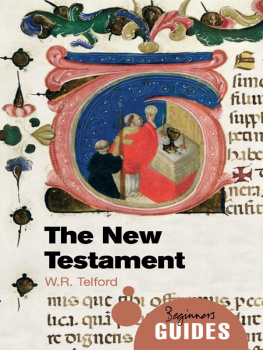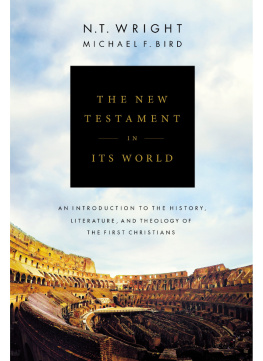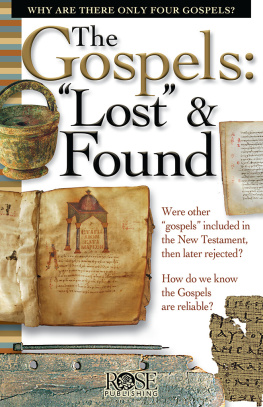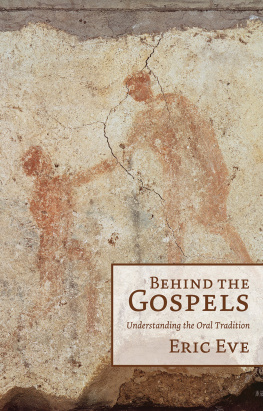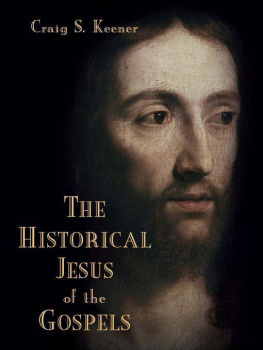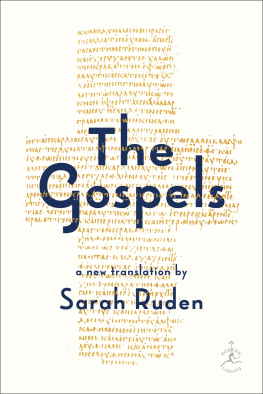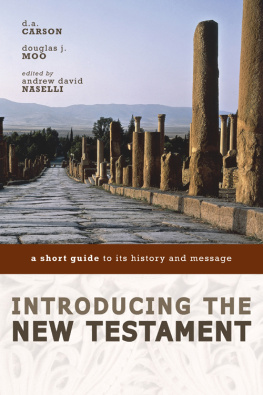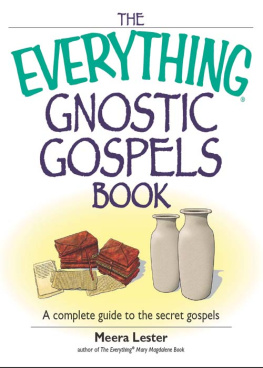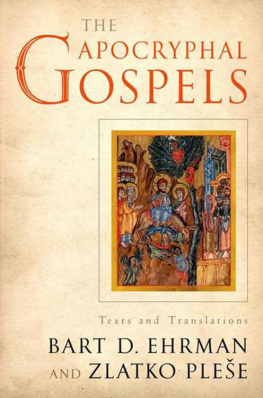The New Testament
A Beginners Guide
ONEWORLD BEGINNERS GUIDES combine an original, inventive, and engaging approach with expert analysis on subjects ranging from art and history to religion and politics, and everything in between. Innovative and affordable, books in the series are perfect for anyone curious about the way the world works and the big ideas of our time.
aesthetics
africa
american politics
anarchism
animal behaviour
anthropology
anti-capitalism
aquinas
art
artificial intelligence
the bahai faith
the beat generation
the bible
biodiversity
bioterror & biowarfare
the brain
british politics
the Buddha
cancer
censorship
christianity
civil liberties
classical music
climate change
cloning
cold war
conservation
crimes against humanity
criminal psychology
critical thinking
daoism
democracy
descartes
dewey
dyslexia
energy
the enlightenment
engineering
epistemology
european union
evolution
evolutionary psychology
existentialism
fair trade
feminism
forensic science
french literature
french revolution
genetics
global terrorism
hinduism
history of science
homer
humanism
huxley
international relations
iran
islamic philosophy
islamic veil
journalism
judaism
lacan
life in the universe
literary theory
machiavelli
mafia & organized crime
magic
marx
medieval philosophy
middle east
modern slavery
NATO
nietzsche
the northern ireland conflict
nutrition
oil
opera
the palestineisraeli conflict
particle physics
paul
philosophy
philosophy of mind
philosophy of religion
philosophy of science
planet earth
postmodernism
psychology
quantum physics
the quran
racism
reductionism
religion
renaissance art
the roman empire
the russian revolution
shakespeare
the small arms trade
sufism
the torah
united nations
volcanoes
The New Testament
A Beginners Guide
W. R. Telford
A Oneworld Book
This paperback edition published in 2014
Originally published in 2002 as The New Testament: A Short Introduction: A Guide to Early Christianity and the Synoptic Gospels
Copyright W. R. Telford 2002, 2014
The moral right of W. R. Telford to be identified as the Author of this work has been asserted by him in accordance with the Copyright, Designs, and Patents Act 1988
All rights reserved
Copyright under Berne Convention
A CIP record for this title is available from the British Library
ISBN 978-1-78074-338-7
eISBN 978-1-78074-339-4 (eBook)
Typeset by Cenveo Publishing Services, Bangalore, India
Oneworld Publications
10 Bloomsbury Street
London WC1B 3SR
United Kingdom
Stay up to date with the latest books, special offers, and exclusive content from Oneworld with our monthly newsletter
Sign up on our website
www.oneworld-publications.com
To Andrena
Contents
Tables
Figures
This book was written over a period of six weeks spent at St Deiniols Library, Hawarden in North Wales. My thanks must go, first of all, to the Trustees, Warden and Staff of the Library for all the support, help and encouragement they have offered me, not only during this period, but at all the other times when I have had the privilege and joy of working here. Particular thanks go to the Trustees for awarding me a Revd Dr Murray McGregor Memorial Scholarship, and to the Warden and Chief Librarian, the Revd Peter Francis, for his enduring friendship and assistance. For making it possible for me to have a period of study leave, my appreciation goes to my colleagues in the Department of Religious Studies at Newcastle University, and to the Dean of the Faculty of Arts, Dr Eric Cross. This book is based on a series of lectures given over the years to my first year undergraduates at Newcastle. My thanks, therefore, go to them, for the interest they have shown in the New Testament, and for the stimulation they have provided to put these lectures into published form. My gratitude also extends to Oneworld, for making it possible for me to publish The New Testament: A Beginners Guide, and to its enterprising publisher, Novin Doostdar, for his patience, encouragement and good humour. Last, but certainly not least, I would like to thank, as always, my dear wife, Andrena, for being my number one supporter, for giving me the benefit of her advice and judgement, and, above all, for being, at all times, her loving, charming and cheerful self.
No other collection of writings is perhaps better served with Guides and Introductions, both scholarly and popular, than the New Testament. To supply yet another might seem at best unnecessary, at worst impertinent. Further, to offer a beginners guide not only to the New Testament, but to early Christianity and the Synoptic Gospels as well, when others have written, at length and in depth, on these weighty subjects, and on these significant texts, might appear no less than foolhardy. Clearly, therefore, a strategy is required. This Beginners Guide proceeds from the presupposition that the historical value of the New Testament writings lies in the fact that they represent (though not exclusively, as we shall see), the foundation documents of early Christianity. To understand them, one must therefore have a broad, historical awareness of the wider social, economic, political, cultural and religious context in which they were produced. To appreciate them, one must also have a more specific knowledge and understanding of the needs, circumstances and ideology of the first- and second-century Christian communities out of which they arose. To interpret them in their original context, furthermore, one must have some grasp of the methods of historical criticism which contemporary scholars apply to them (especially to the Gospels), and there is no better way to do this than to become familiar with at least some of the texts in some depth.
These presuppositions help define the strategy I have adopted in this book. Given its nature and scope, and the fact that it would be impossible to do justice to all twenty-seven of the writings which make up the New Testament, we shall proceed, therefore, in a series of ever-narrowing circles, moving from the general to the particular. In the first chapter, entitled The World of the New Testament, I shall be providing a survey of the creative milieu in which Christianity was born, giving due weight to the fact that this new religious movement was a product of two chromosomes, if you like, one provided by Hellenism, the other by the mother-religion, Judaism. The womb in which this new age child was conceived was the Roman Empire. In the second chapter, we shall examine the early church, outlining its origins and history, and commenting on the nature and development of belief and practice in the New Testament period (30150 CE). Then, in our third and central chapter, we shall move on to the literature produced by the early church, the New Testament writings themselves. Here, I shall be pointing out the factors that led to the emergence of these writings, and offering a brief introduction to them. For more detailed information, the reader will be referred to the more specialized help that is available. In the fourth and fifth chapters, our focus will become narrower still. Here, I shall be concentrating on the special Gospel literature in which many of the traditions about Christianitys founder, Jesus, are found (in particular the Synoptic Gospels), and we shall conduct this study armed with the tools that scholars use to interpret them.

